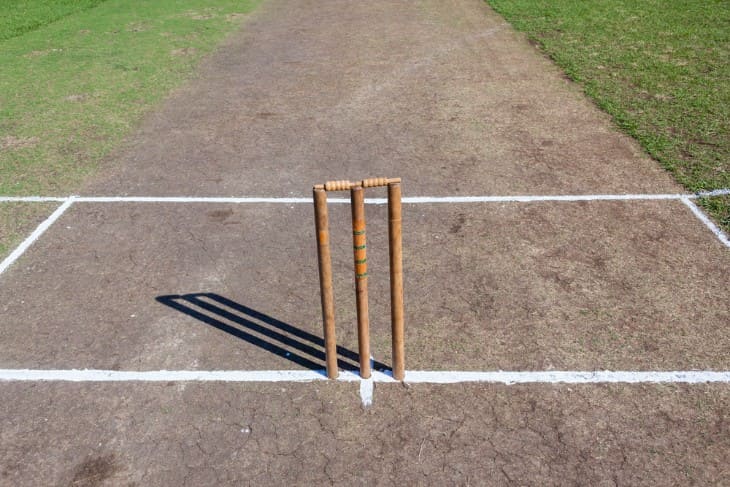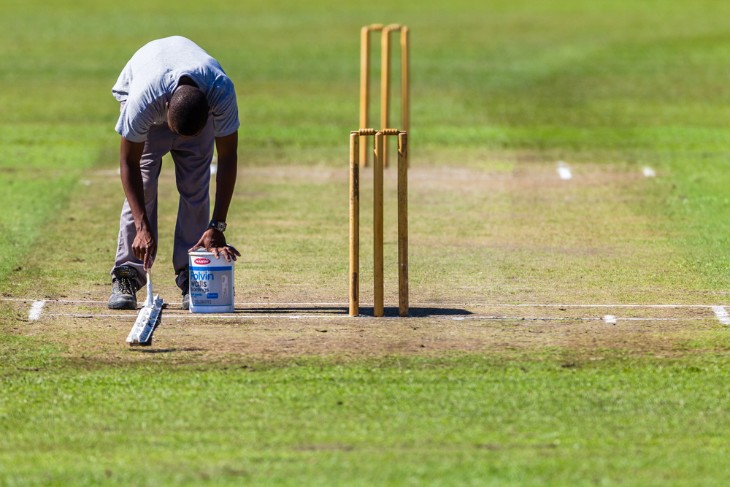The preparation of a cricket pitch is a crucial aspect of the sport, significantly affecting the dynamics and outcomes of matches. This process involves a precise combination of scientific knowledge and groundskeeping skill, crafting a surface that meets the specific requirements of cricket. The pitch is pivotal across various formats, from the traditional Test cricket to the fast-paced limited-overs games, influencing player strategies and the results of matches.
In examining the science of pitch preparation, we look at the numerous factors that determine its behavior, such as soil composition, grass type, and climate conditions. This exploration also covers the innovative methods emerging in pitch care, which are shaping the future of this essential element of cricket. Understanding pitch preparation helps us appreciate the complex interplay between the playing surface and the sport's tactical and stylistic nuances.
Components of Pitch Preparation
A. Soil Composition and Its Significance
The composition of the soil is fundamental in shaping the behaviour of a cricket pitch. Different soil types—clay, loamy, and sandy—affect how the ball reacts upon landing. Clay-rich soil, often used in pitch preparation, tends to retain moisture, resulting in slower pitches that offer more assistance to spin bowlers due to better grip. In contrast, sandy soil, known for its quick drainage, typically yields faster pitches with less spin. Understanding the nuances of each soil type is vital in creating pitches that cater to various playing styles and strategies.
When selecting the soil for a pitch, several factors come into play. Climate considerations are pivotal; soils that can adapt to varying weather conditions, such as excessive heat or rain, are preferred. Additionally, the frequency of matches on the pitch determines the resilience required from the soil. Moreover, the balance between batting and bowling must be considered, aiming for a fair contest between bat and ball.
B. Ground Preparation Techniques
Rolling stands as a fundamental technique in preparing a cricket pitch. The use of heavy rollers contributes to compaction and pitch hardness, affecting the bounce and speed of the ball. Varying types of rollers are employed throughout the preparation process, with heavy rollers used initially for firmness and lighter ones for final touches. The timing and frequency of rolling play a crucial role in determining the final condition of the pitch, demanding precision and expertise from groundsmen.
Moisture control plays a pivotal role in pitch preparation. Achieving optimal moisture content is key to strike a balance between pitch hardness and bounce. Groundsmen employ different watering techniques, from surface watering to soaking, carefully managing soil moisture levels. Additionally, the strategic use of covers helps protect the pitch from excessive rain or aids in retaining essential moisture.
Grass management on the pitch encompasses aspects such as grass length and density. The length of the grass is tailored to suit the desired pace of the pitch—shorter grass encourages faster pitches, while longer grass slows down the ball. Moreover, grass density significantly influences the behaviour of the ball, especially concerning seam movement. Regular trimming and meticulous maintenance ensure consistent grass height and evenness across the pitch, contributing to a uniform playing surface.
These meticulous soil and ground preparation techniques collectively define the characteristics of a cricket pitch, playing a pivotal role in determining the nature of play and the balance between batsmen and bowlers during a match.

Factors Influencing Pitch Behavior
Weather Conditions:
Weather has a profound impact on pitch behaviour. Temperature, humidity, and rain significantly influence how the pitch plays. For instance, hot and dry weather might cause the pitch to crack, aiding spin bowlers, while damp and overcast conditions might assist seam bowlers by providing swing and movement off the pitch.
Wear and Tear during Matches:
As the match progresses, the pitch undergoes wear and tear. Footmarks from bowlers, rough patches, and general degradation affect the bounce, pace, and spin, making the pitch more unpredictable and challenging for batsmen.
Ball Type (Red vs. White):
Different cricket formats use different types of balls. Red balls, typically used in Test matches, tend to retain their shine for longer periods, aiding swing and movement. White balls, used in limited-overs cricket, deteriorate faster, affecting swing and making it harder for spinners to grip.
Role of Soil and Its Properties
Impact of Soil Moisture on Bounce and Pace:
Soil moisture profoundly influences pitch behaviour. Moist soil tends to offer more grip to spinners and results in slower pitches, whereas drier soil creates faster pitches with more bounce, favouring fast bowlers.
Soil Compactness and Its Effects on Ball Movement:
The compactness of the soil dictates how the ball behaves on the pitch. Well-compacted soil tends to provide a more consistent bounce, aiding both batsmen and bowlers in predicting the ball's movement. Loose or uneven soil can create irregular bounces, making it difficult for batsmen to anticipate the ball's trajectory.
Relationship Between Soil Fertility and Pitch Quality:
The fertility and health of the soil impact pitch quality. Healthy soil, rich in nutrients and organic matter, provides better stability, aiding in consistent bounce and pace. Moreover, fertile soil allows for better grass growth, contributing to a well-maintained pitch surface.
Understanding these soil properties and how they interact with external factors helps groundsmen and curators in preparing pitches that offer a fair balance between batting and bowling. Adjusting these variables allows them to tailor the pitch conditions to suit the desired style of play and create an engaging contest between bat and ball during cricket matches.
Pitch Preparation Techniques Across Various Formats
A. Test Cricket Pitch Preparation
Test cricket demands pitches that offer a balanced contest between bat and ball across multiple days. The preparation of Test pitches involves meticulous planning to ensure endurance and variation over extended periods. Groundsmen aim for pitches that gradually evolve, starting with a bit of moisture to assist fast bowlers initially, while allowing for wear and tear to aid spinners in later stages. These pitches typically encourage stroke-making while also offering challenges as the match progresses, emphasizing the traditional skills of both batsmen and bowlers.
B. One-Day and T20 Cricket Pitch Preparation
In limited-overs cricket, especially One-Day Internationals (ODIs) and T20 matches, the focus is often on creating pitches conducive to higher scoring and entertaining cricket. Groundsmen prepare surfaces that facilitate stroke play and encourage aggressive batting. Pitches for shorter formats are generally flatter, with even bounce, allowing batsmen to play their shots freely. The aim is to provide an exciting spectacle for the audience while maintaining a fair balance between bat and ball, albeit leaning slightly towards favouring batsmen.
C. Strategies to Maintain Pitch Integrity Across Formats
Across all formats, maintaining the integrity of the pitch is crucial. Groundsmen adapt their techniques to ensure that the pitch doesn't deteriorate excessively, especially in shorter formats where wear and tear need to be managed within a limited timeframe. They employ methods like selective rolling, controlled moisture management, and strategic grass maintenance to sustain pitch quality throughout the match.
D. Balancing Pitch Conditions for Exciting Gameplay
Finding the right balance in pitch preparation is an ongoing challenge. Groundsmen need to strike a balance between providing a surface that aids shot-making without making it overly one-sided. For instance, in T20 cricket, pitches should encourage high-scoring games but not at the expense of eliminating the role of bowlers entirely. Adjusting grass length, soil moisture, and rolling techniques are some strategies used to achieve this delicate equilibrium.
E. Tailoring Pitches to Venue and Team Preferences
Another aspect of pitch preparation involves tailoring pitches based on venue characteristics and team preferences. Some venues are known for specific pitch behaviours—some might favour spinners due to soil composition, while others might assist pace bowlers due to weather conditions. Curators also consider home team preferences, occasionally preparing pitches that align with their strengths to provide a slight advantage.
Understanding the demands of each format and employing specific techniques allows groundsmen and curators to create pitches that not only adhere to the essence of the game but also ensure an exciting and competitive cricketing experience for players and spectators alike.

Innovations and Future Directions
Innovations in technology, combined with a focus on sustainability and data-driven approaches, are shaping the future of pitch preparation in cricket. Embracing these advancements while addressing challenges will be pivotal in ensuring that cricket continues to be played on surfaces that offer a fair and exciting contest between bat and ball.
Innovations in Pitch Preparation
In recent years, technological advancements have significantly influenced pitch preparation in cricket. Innovations like sensor technology embedded in pitches allow for real-time monitoring of soil moisture, temperature, and pitch behaviour. This data assists groundsmen in making informed decisions regarding watering, rolling, and overall pitch maintenance. Furthermore, the use of data analytics helps curators understand trends in pitch behaviour across matches, enabling them to prepare surfaces that suit the desired style of play.
Role of Groundskeeping Techniques
Groundskeeping techniques continue to evolve, incorporating modern machinery and equipment. Automated irrigation systems precisely control soil moisture levels, ensuring optimal playing conditions. Moreover, the development of specialized machinery, such as advanced rolling equipment, enables groundsmen to fine-tune pitch characteristics more effectively. These advancements not only enhance pitch quality but also contribute to the sustainability and longevity of pitches.
Sustainable Pitch Preparation Practices
The future of pitch preparation in cricket is increasingly inclined towards sustainability. Groundsmen are exploring environmentally friendly approaches, such as using organic fertilizers and employing eco-friendly methods to manage pests and diseases. Additionally, there's a growing emphasis on water conservation through innovative irrigation systems and rainwater harvesting techniques. Sustainable pitch preparation not only minimizes environmental impact but also ensures consistent pitch quality in the long term.
Future Directions and Challenges
Looking ahead, the integration of artificial intelligence (AI) and machine learning could revolutionize pitch preparation. Predictive models based on historical data and environmental factors might enable curators to forecast pitch behaviour more accurately. However, challenges persist, including maintaining the balance between bat and ball on pitches that cater to diverse playing styles and preferences. Furthermore, adapting to changing climatic conditions poses a significant challenge, requiring innovative approaches to ensure pitch quality remains consistent in varied weather scenarios.
Summary
In cricket, groundsmen play a vital role across all formats, from endurance-testing Test matches to high-energy limited-overs games, by meticulously preparing pitches that are central to the sport's character. Technological advancements have transformed this process, enabling real-time data analysis and promoting sustainable methods, all while maintaining the game's integrity.
As cricket progresses, pitch preparation faces both challenges and opportunities. Groundsmen must contend with varying weather conditions, soil characteristics, and player preferences to craft pitches that offer a fair contest between batsmen and bowlers. Looking forward, we can expect further innovations such as the use of AI and continued emphasis on sustainable practices, enhancing pitch quality and predictability.
For more information:


